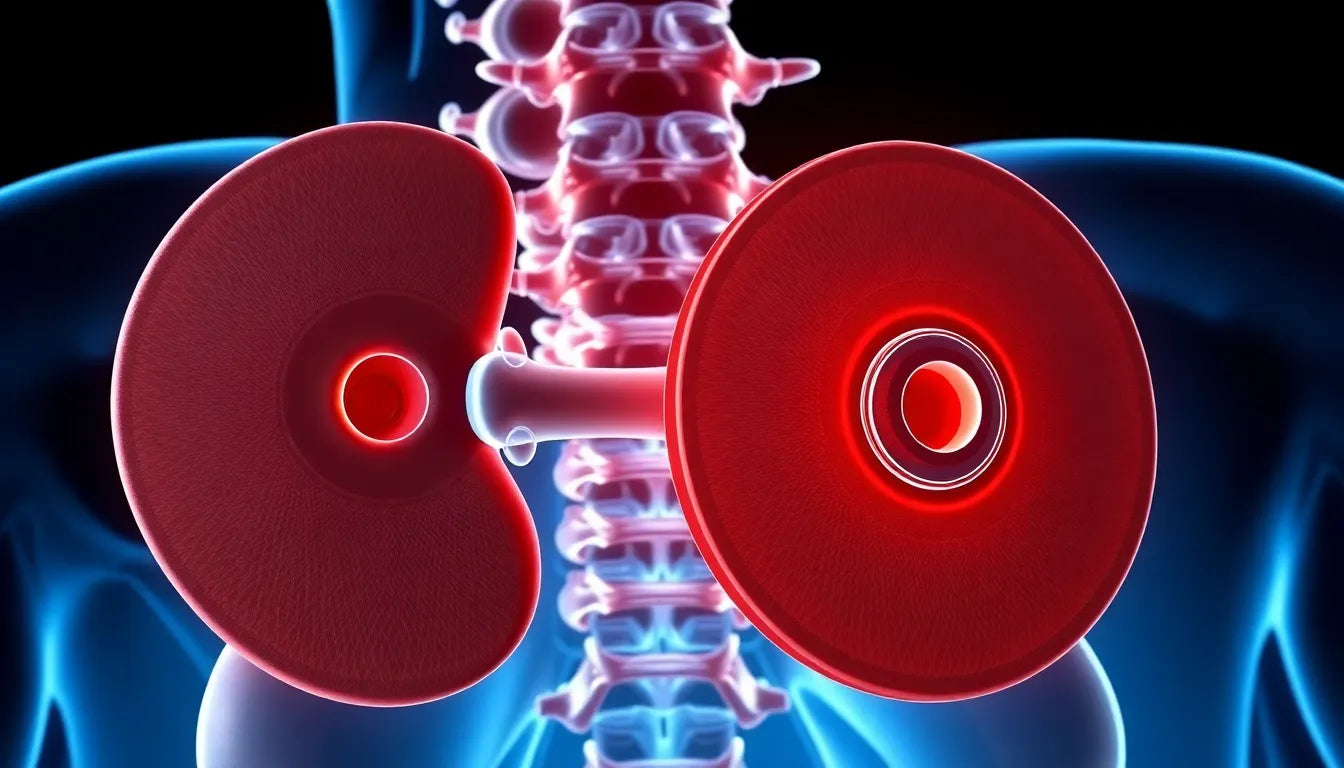Experiencing back pain can be a common occurrence, but when it escalates to a herniated disc, the impact can be significant and debilitating. A herniated disc, often referred to as a slipped or ruptured disc, occurs when the soft inner gel of a spinal disc pushes through a crack in the tougher exterior casing. This condition can cause a variety of symptoms, ranging from mild discomfort to severe pain, depending on the location and severity of the herniation.
Understanding the prevalence and impact
Herniated discs are more common than many might think, particularly among adults aged 30 to 50. This prevalence is largely due to age-related wear and tear on the spine, as well as lifestyle factors such as poor posture, heavy lifting, and sedentary habits. The impact of a herniated disc on daily activities and overall quality of life can be profound. Simple tasks like sitting, walking, or even lying down can become challenging and painful, affecting both physical and mental well-being.
Recognizing the symptoms of a herniated disc early is crucial for effective management and treatment. Early intervention can prevent further complications and help individuals regain control over their lives. This article aims to shed light on what a herniated disc feels like, focusing on the sensations and symptoms associated with this condition.
Common sensations and symptoms
The symptoms of a herniated disc can vary widely depending on its location in the spine. Cervical herniated discs, located in the neck, often cause neck pain, numbness, or tingling that radiates down the arms and into the hands. Additionally, individuals may experience a dull or sharp pain between the shoulder blades, along with muscle weakness in the arms and hands. In some cases, symptoms such as frequent urination and headaches may also occur.
On the other hand, lumbar herniated discs, found in the lower back, typically result in lower back pain that worsens with prolonged sitting, standing, or driving. A common symptom is sciatica, which is characterized by pain radiating from the buttocks down the leg to the calf or foot. Muscle spasms in the back, as well as numbness, tingling, or weakness in the leg or foot, are also frequent complaints. Reduced reflexes in the knee or ankle can further indicate a lumbar herniated disc.
Understanding these sensations and symptoms is key to identifying a herniated disc and seeking appropriate medical advice. The next sections will delve deeper into the anatomical explanations and the progression of symptoms, providing a comprehensive guide to managing this condition effectively.
anatomical explanation and symptom segmentation
To fully grasp what a herniated disc feels like, it's important to understand the anatomy involved. The spine is composed of a series of vertebrae, cushioned by discs that act as shock absorbers. These discs have a tough outer layer and a softer, gel-like center. A herniated disc occurs when the inner gel pushes through a tear in the outer layer, potentially irritating nearby nerves.
The location of the herniated disc in the spine significantly influences the symptoms experienced. Let's break down these symptoms based on their location:
cervical herniated disc symptoms
When a disc herniates in the cervical region, or neck area, it often leads to specific symptoms:
- Neck pain: This can manifest as a persistent ache or sharp pain, particularly in the back and sides of the neck.
- Numbness or tingling: These sensations may radiate down the arms and into the hands, often accompanied by a feeling of pins and needles.
- Pain between the shoulder blades: This can be dull or sharp, adding to the discomfort.
- Muscle weakness: Individuals might experience weakness in the arms and hands, affecting their grip and dexterity.
- Occasional symptoms: Some people report frequent urination and headaches, although these are less common.
lumbar herniated disc symptoms
In contrast, a herniated disc in the lumbar region, or lower back, presents a different set of symptoms:
- Lower back pain: This pain often intensifies with activities like prolonged sitting, standing, or driving.
- Sciatica: A hallmark symptom, sciatica is characterized by pain radiating from the buttocks down the leg to the calf or foot.
- Muscle spasms: These involuntary contractions can cause significant discomfort in the back.
- Numbness, tingling, or weakness: These symptoms can affect the leg or foot, complicating mobility.
- Reduced reflexes: Reflexes in the knee or ankle may be diminished, indicating nerve involvement.
descriptive sensations and symptom triggers
Understanding the sensations associated with a herniated disc is crucial for recognizing the condition. People often describe these sensations using terms like "burning," "tingling," or "radiating pain." These descriptors capture the nerve irritation and inflammation caused by the herniated material pressing on nearby nerves.
Certain activities can exacerbate the pain of a herniated disc. Actions that increase pressure on the spine, such as coughing, sneezing, or bearing down, can intensify symptoms. This is because these actions momentarily increase intradiscal pressure, potentially worsening nerve compression.
Recognizing these triggers and understanding the sensations they cause can help individuals manage their condition more effectively. By avoiding or modifying activities that exacerbate pain, it's possible to reduce discomfort and improve quality of life.
In the next section, we will explore the progression and severity of symptoms, as well as emergency warning signs that necessitate immediate medical attention. This will provide a comprehensive understanding of how a herniated disc impacts daily life and when to seek professional help.
Progression and severity of herniated disc symptoms
The symptoms of a herniated disc can evolve over time, starting with mild discomfort and potentially progressing to severe neurological issues. Initially, individuals might experience occasional pain or tingling, which can be mistaken for minor muscle strain or fatigue. However, as the condition progresses, these symptoms can intensify. Pain may become more constant and severe, significantly impacting daily activities and quality of life.
In some cases, the condition can lead to chronic pain or permanent nerve damage if left untreated. This underscores the importance of early diagnosis and intervention. Long-term progression might include increased pain episodes, more pronounced muscle weakness, and reduced mobility, emphasizing the need for ongoing management and monitoring.
Emergency warning signs
While many symptoms of a herniated disc can be managed with medical guidance, certain signs require immediate attention. Severe symptoms such as loss of bowel or bladder control, extreme muscle weakness, or numbness in the groin area, known as saddle anesthesia, indicate possible cauda equina syndrome. This is a rare but serious condition that demands urgent medical intervention to prevent permanent damage.
Comparative and unique symptom insights
Interestingly, cervical disc herniation can sometimes mimic symptoms of more serious conditions, such as heart disease. For instance, the pain may radiate to the chest, leading individuals to mistakenly attribute it to cardiac issues. Differentiating between continuous and intermittent pain patterns is crucial in understanding the nature of the herniation. Continuous pain suggests ongoing nerve irritation, while intermittent pain might indicate positional or activity-related exacerbation.
Frequently Asked Questions
What does a herniated disc feel like initially?
Initially, a herniated disc may feel like a mild ache or stiffness in the back or neck, which can easily be mistaken for muscle strain. As the condition progresses, sensations such as tingling, burning, or pain radiating to the limbs may develop, signaling nerve involvement.
How can I tell if my pain is from a herniated disc or something else?
Distinguishing herniated disc pain from other conditions involves assessing the pattern and location of symptoms. Pain that radiates or is accompanied by numbness, tingling, or weakness in the limbs is often indicative of a herniated disc. Consulting a healthcare professional for a thorough evaluation is recommended for an accurate diagnosis.
Can a herniated disc heal on its own?
A herniated disc can sometimes heal naturally over time, as the body absorbs the protruding material and inflammation decreases. However, this process can take weeks to months, and medical intervention might be necessary if symptoms persist or worsen.
What are the long-term effects of an untreated herniated disc?
Leaving a herniated disc untreated can lead to chronic pain, permanent nerve damage, and reduced mobility. It can also increase the risk of developing other spinal issues. Timely management is crucial to prevent these complications and improve outcomes.
Sources
- Cleveland Clinic. "Herniated Disk: Symptoms, Causes, and Treatments."
- Penn Medicine. "Herniated Disc: Overview and Symptoms."
- American Association of Neurological Surgeons (AANS). "Herniated Disc."
- NewYork-Presbyterian. "Herniated Disc: Symptoms and Treatments."
- Harvard Health. "Understanding Herniated Discs."
- Johns Hopkins Medicine. "Herniated Disk: Symptoms and Diagnosis."


















